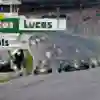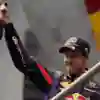F1
More facts and figures to consider when comparing the mid-Eighties turbo era with that of 2014...
In Part 1, we looked at just some of the many ways turbo technology has shifted on in the last quarter of a century, but there are more.
Turbocharging in the early Eighties was very much in its infancy although the technology had moved forwards rapidly by its closure in 1988. It’s a technology that has become the norm in road cars since and, with 21st century know-how applied plus the modern-day desire to push new boundaries when it comes to energy efficiency, F1’s engine manufacturers have a much broader base from which to work.
Take, for example, ‘turbo lag’, that horrible delay between throttle application and power delivery. It’s actually a thing of the past in many respects for modern designs and it’s hard to imagine anyone going to the grid in 2014 with the two-second plus ‘nothing then everything’ experiences from the Eighties.
Bear in mind, too, that in the early Eighties many chassis were still made of aluminium and would actually flex from the strain exerted on them by the turbo engines. With less power plus state of the art carbon fibre chassis, that simply won’t happen this time around.
It’s also fascinating to consider the fuel allowances then and now. In 1984 fuel tanks were capped at 220 litres, in 1986 that became 195 litres and in 1988, the final year for turbos, 155 litres. It was all in an attempt to cut race speeds with drivers needing to go into ‘conservation mode’… only for the boffins of top engine manufacturers, such as Honda, Porsche and Ferrari to swiftly overcome such limitations. Fast forward to 2014 and consider that the same race distances will have to be achieved with just 100kgs of fuel… now that is a test for the manufacturers.
There are other obvious differences that spring out, too. Mid-Eighties F1 engines varied from 1.5-litre and four cylinders to 1.6-litre V6 designs revving upwards of 12000rpm. For 2014 one rule fits all with 1.6-litre V6s capped at 15000rpm.
Now also consider that three of F1’s current engine manufacturers – Ferrari, Renault and, when it re-appears in 2015, Honda – also raced in the mid-Eighties turbo era. Be clear on one thing, though – what they learned then is meaningless compared to 2014 turbo designs.
And there’s another factoid to throw in – a 2014 turbocharged F1 grid will, unless someone else surprises us all, boast just four different engine manufacturers; flash back to 1986 when every team had finally gone turbo and there were nine – TAG Porsche, Honda, Ferrari, Renault, BMW, Ford, Zakspeed, Alfa Romeo and Motori Moderni.
Seven of today’s circuits – Hockenheim, Interlagos, Monaco, Monza, Silverstone, Spa-Francorchamps – were also used by the first breed of turbocharged F1 cars. Comparing lap times will be almost futile with four in particular having undergone significant alterations to their lay-outs. Spa, Monza and Monaco still retain their inherent shapes so perhaps some parallels can be drawn in terms of time to complete longer straights. Straights? Actually just make that Spa and Monza…






